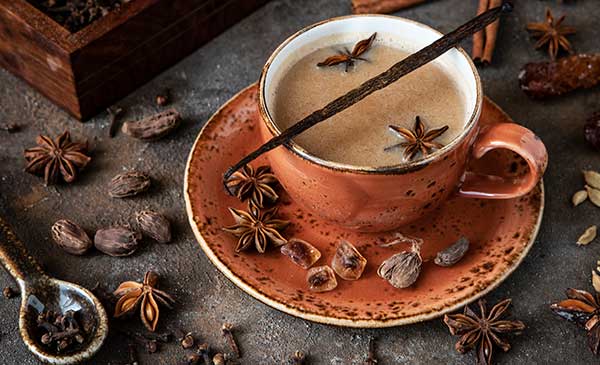What Is Chai Tea? The Ritual of a Global Favorite

For many, the word chai evokes images of spicy aromas and the comforting balance of sweetness, spice, and creaminess. But what exactly is chai tea — and how did it become such a beloved beverage worldwide?
Let’s dive into the rich story behind chai and explore what sets it apart. We'll unravel how this ancient Indian drink evolved into the coffee shop staple we know today.
The Word "Chai" — More Than Just Tea
First things first: saying “chai tea” is technically redundant. In Hindi and many other languages, chai simply means “tea.” So when you say “chai tea,” you’re actually saying “tea tea.”
But in the Western world, the phrase has come to represent a very specific kind of spiced tea—masala chai—which originated in India.
In India, chai is everywhere. It's not just a drink—it’s a daily ritual, a cultural connector, and a symbol of hospitality. Vendors known as chaiwalas line busy streets brewing fresh batches over open flames. Friends linger over cups, family recipes are passed down generations, and travelers find community in roadside tea stalls.

The Roots of Chai: A Spiced Tradition
Chai’s origins trace back thousands of years to Ayurvedic traditions in the Indian subcontinent. Initially, it was more of a health tonic than a daily beverage. Brewed from a mix of warming spices, it was consumed to aid digestion, boost immunity, and balance the body.
It wasn’t until the British colonized India and began cultivating tea in Assam in the 19th century that black tea was introduced to the Indian population on a wide scale. The British East India Company aimed to rival China’s tea monopoly, so they encouraged tea drinking among Indians—but locals made it their own.
By combining black tea with milk, sugar, and traditional spices like cardamom and ginger, masala chai as we know it was born.
What’s in a Cup of Chai?
While there’s no single “right” way to make chai, most versions include four key components:
Tea: Traditionally, chai is made with strong black tea leaves, typically a bold Assam or Darjeeling tea, which can hold up to the spices and milk. But modern takes on chai use other types of teas beyond black:
- Chai Green tea: Offers a lighter, more delicate base. Green tea brings grassy, fresh notes that pair beautifully with milder spices like cardamom and fennel. It’s lower in caffeine and a great option for those who prefer a gentler brew.
- Herbal chai: Naturally caffeine-free, herbal chai blends use rooibos, chamomile, or even peppermint as a base. Rooibos chai is especially popular for its earthy-sweet flavor and antioxidant content.
- White tea chai: Rare but luxurious, white chai uses minimally processed white tea. It results in a subtler, floral cup that lets spices shine in a more nuanced way.
Milk: Often whole milk or a mix of water and milk, though dairy-free alternatives like oat, almond, soy, or coconut milk have become increasingly popular. These also open new flavor dimensions in your chai.
Sweetener: Cane sugar (white sugar) is most traditional, but honey, agave, maple syrup, brown sugar, rock sugar, or even date syrup can bring out the spices in different ways.
Spices: The heart of chai. Cardamom pods, cinnamon, cloves, fresh ginger, and black peppercorns are staples. Other additions might include nutmeg, star anise, fennel seeds, or rose petals.

Why Chai Captivates the Senses
The beauty of chai lies in its complexity. The interplay of warming spices with bold black tea, softened by creamy milk and sweetened just right, creates a symphony of flavors. It’s comforting and invigorating all at once.
From a wellness perspective, the spices used in chai aren’t just flavorful—they also offer a range of benefits. Ginger aids digestion, cardamom supports respiratory health, cinnamon helps regulate blood sugar, and cloves offer antioxidant properties.
Whether you sip it for pleasure or wellness (or both), chai invites you to slow down and savor.
Chai Around the World
While India remains chai’s spiritual and cultural home, the drink has traveled widely and evolved in the process.
- In the West, chai became popularized in cafes and coffee shops—often as a chai latte, which typically uses steamed milk and a sweetened concentrate rather than the traditional method of boiling loose tea and spices together.
- In East Africa, chai is a common beverage, often strong, milky, and sweet.
- In the Middle East, cardamom tea bears a resemblance to chai, emphasizing similar warming spice blends.
- In America, "chai" can refer to a broad range of flavored tea beverages, some far from the traditional Indian preparation.
Each interpretation reflects local ingredients, tastes, and traditions. But the essence of chai—its warmth and sociability—remains intact.
From Traditional to Trendy: The Rise of the Dirty Chai
As we dive into modern variations, it’s important to note: don’t confuse traditional chai with a dirty chai. While both are delicious, they’re quite different. A classic masala chai is a spiced tea brewed with milk and sweetener—no coffee involved.
What is a dirty chai?
A dirty chai, on the other hand, is a fusion drink that combines a chai latte with a shot of espresso, blending the warm spices of chai with the bold intensity of coffee. It’s a modern twist that has become especially popular in cafés.
Short on Time? Try Chai Concentrate
If you’re craving convenience but want to skip the overly sweet store-bought versions, making a chai concentrate at home is a great option.
A concentrate is essentially a strong, spiced tea base that you can store in the fridge and mix with milk (hot or iced) whenever you need a quick chai fix.
Check out our full How to Make Chai Concentrate guide. This chai recipe is complete with variations for sweeteners, storage tips, and caffeine-free options.
Chai, Your Way
Whether you enjoy it steeped in tradition or swirled with espresso, chai is an incredibly versatile drink that’s easy to make your own. Its timeless blend of tea, spices, and warmth continues to bring people together—from Indian street corners to cozy kitchens across the world.
If you’re just beginning your chai journey, start simple and explore. Try different spice blends, adjust your sweetener. Add the milk or switch up your milk. The beauty of chai is that there’s no wrong way to make it—only your way.
Happy sipping!






